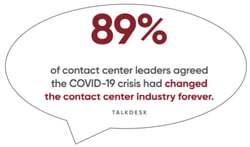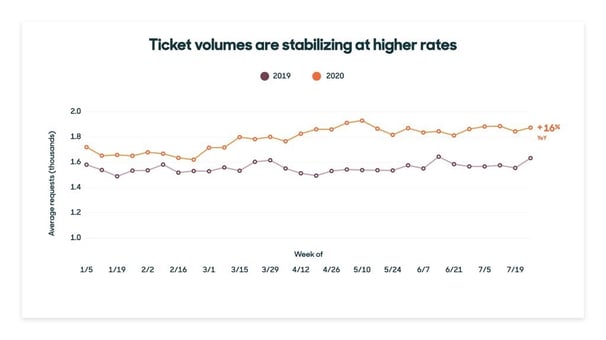Blog#4 New Normal Series – Lasting Impact of COVID 19 on the Customer Experience

How the wake of a global emergency is dramatically shifting Customer Engagement and the daily operations of Contact Centers.
As a direct result of COVID-19, some dramatic changes are taking place in the contact center industry. All over the world customer service leaders agree that COVID-19 has changed the contact center industry forever. We have seen a major shift in contact center operations while higher volumes of customer requests seem to be here to stay. With elevated levels of customer engagements, consumer feedback is becoming more and more important as online shopping and mobile usage spike. Consumer insights are emerging as the key differentiator for companies moving into the new climate while the value of brand ambassadors becomes even more critical to brands meeting their CX objectives.

Looking at 2021, we believe that the negative implications of the pandemic will substantially decline. However, we do not see the industry changing back to where it was pre-COVID-19. Below are a few fundamental changes we believe will survive in a post pandemic economy:
1. Shifting Traditional Call Centers to Virtual At-home Operations
It’s no secret, COVID-19 has turned a lot of traditional business operations upside down. According to Gartner, pre-outbreak of the pandemic, nearly 7 in 10 (68%) of customer service and support organizations worked from traditional call centers, and less than 10% of team members worked from home. That is now completely flipped going forward, as 71% of contact centers will be remote. COVID-19 also had a huge impact on efficient agent on-boarding and management. For many companies, the pandemic has also sparked the shift in thinking from using a mix of off-shore/on-shore call centers to managing domestic operations only. The spread of COVID-19 in countries such as the Philippines and India significantly reduced workforce capacity as a reliable work-from-home option is not widely available in those countries. Many businesses see no choice other than to keep teams in the U.S. and add or re-skill other staff to be contact center agents.
2. Larger Volumes of Customer Requests Here to Stay
Data of the US Department of Commerce shows a quantum leap in ecommerce which share of overall retail jumped from 15.8% in 2019 to 21.3% in 2020. As customers increase their online buying in the safety of their own homes, ecommerce purchasing volume continues to grow. Since e-commerce retail has a significant higher order/contact ratio due to the added delivery component, customer service volume will increase. McKinsey research revealed more customers plan to continue buying online even after the crisis has ended. Zendesk found that even though tickets are stabilizing, the average number of requests clients are receiving, is at least 16% higher than pre-COVID-19. Customer engagement teams should expect that trend to continue for the weeks and months ahead due to the lasting shift from traditional retail to e-commerce.

3. The Rising Importance of Customer Insights
In SurveyMonkey’s CX Insights report, 87% of respondents underscored how much more important customer feedback has become since the pandemic began. More people are likely to switch brands as 2021 unfolds. More than half of these survey respondents agree about the increased focus on their CX program from the C-Suite.

As mobile shopping and online shopping increase, more and more consumers are relying on reviews and ratings to dictate who they do business with. COVID-19 has fast tracked the customer experience as the leading KPI for companies going forward.
4. Brand Ambassador Empowerment with Empathy at Core
As a direct result of the unprecedented increase in customer service volume, it is important that all customer service team members are empowered to handle all aspects of customer inquiries without the need to involve supervisors or other team members. In our predictions for 2021, the need for a more empathetic service experience dominated our thinking (Forester). The purpose of customer service is no longer just to alleviate inconveniences; it is to provide fundamental and necessary services for consumers devastated by the COVID-19 pandemic. Ensuring your members have the skills, trust, and empathy will allow them to make the right decisions to deliver excellent customer service.
While we today see some promising signs that the impacts of COVID-19 are gradually declining, there is some concrete evidence that the industry has forever changed due to (i) the lasting structural change of retail, (ii) the shift from traditional call centers to nimble at-home operations and finally (iii) new technology deployments within the contact center industry. While some of those changes were already happening before the pandemic hit and simply have been accelerated, others are a direct result of the new challenges presented by the pandemic. Although structural change is not always easy, we believe what happened over the last 12 months has elevated the importance of Customer Service in general and emphasized the need for delivering authentic, more human customer experiences.
For other helpful ideas on working with your remote team, sign up for our free (no fluff) blog series on “The New Normal” here: https://blog.vipdesk.com/blog
~VIPdesk.com~


